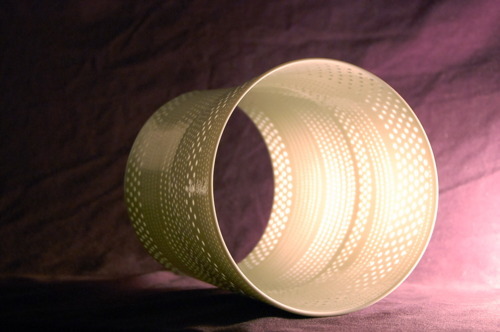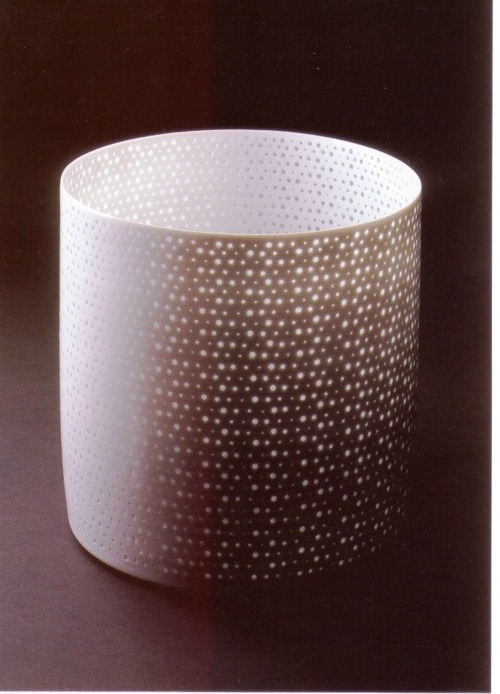
You are about to start working as artist in residence at the Harvard Ceramic Studio. What do you hope you’ll learn from this experience?
I am very interested in the different perspectives on craft art, especially Ceramics between US and Japan. I feel that the vessels are more appreciated in Japan rather than US, as well as the ceramic art itself. I would like to know why and I will research on these issues during my stay at Harvard. I am looking forward to seeing new people who will give me lots of inspiration.
The lightness and pureness of your works make them unique. Tell us more about how do you make them.
White is a simple color, but it can express the subtle nuance between sensibility/ pureness and lights/ shadows.
After I throw the pieces, they are razed as thin as possible, and then I drill the holes with an electric drill, one by one.
After the firing, I sand the surfaces, and the glaze is applied manually into the holes. Another glaze is applied all over the surfaces with a compressor, and then the pieces go into the kiln at 2246(F). It is not so easy to make the smooth surface with a single firing because the holes absorb the glaze very easily, so they need to be fired two or three times to get a nice result.

Luminous Form, 2008, Glazed porcelain, 12” x 8 1/2” – View his works
You mainly work with porcelain, but have you ever tried other materials?
I am also using regular clay in my work. I choose very fine and dense clay for the black tea bowls because I want to show the softness of the black surface. I always choose the clays carefully and mix them in the best way, to express the ideal shape and texture.
Do you remember your early works, back when you discovered ceramic art?
I was always fascinated by Chinese celadon vessels in Sung dynasty, mainly because they have sharp lines. So I was trying to replicate similar pieces when I first started to work with clay.
What form of exhibiting suits you the best? Tell us about your past and future exhibitions or residencies.
The definition of a vessel is a container designed for holding something. And I think that my vessels from my luminous series are made for holding the light. To emphasize the effects of the lights and the vessels, I create a special lighting sets for my exhibition.
I am preparing a few exhibitions in Japan after the residency at the Harvard Ceramic Studio, and I would like to have the chance to show my work outside Japan more often.

Luminous Vessel, 2007, Glazed porcelain, 8 1/2” x 8 ½ ”x 9” – View his works
Among the many talented young Japanese ceramists who have emerged in recent years, each with innovative techniques and distinctively original ideas, NIISATO Akio commands particular attention. He was born in Chiba in 1977, and in 2001 completed his training at the Tajimi City Ceramic and Design Center in a region famous for its dense, rich ceramic history. Since 2002 he has participated in more than 17 group exhibitions in Japan, Korea, Italy, and Switzerland and has been featured in the same number of solo exhibitions in Japan.
Although NIISATO is strongly influenced by traditional Chinese and Japanese porcelains and explores the inherent qualities of porcelain clay that have contributed to its desirability over the centuries, he eschews popular applied surface decorations, and enhances his sleek modern porcelain vessels and sculptural forms solely with the play of light through small glazed “windows” in the translucent surfaces. After he throws the exceptionally thin wall pieces, he uses a small drill to create patterned openings in the clay. During the final firing, his elegant pearl white glaze fills the drilled apertures, allowing the play of light and water to endow these delicate forms with a luminescence comparable to glass.
By Vasi Hirdo.
Published in Ceramics Now Magazine Issue 1.
Visit Niisato Akio’s website.






















Comments 1